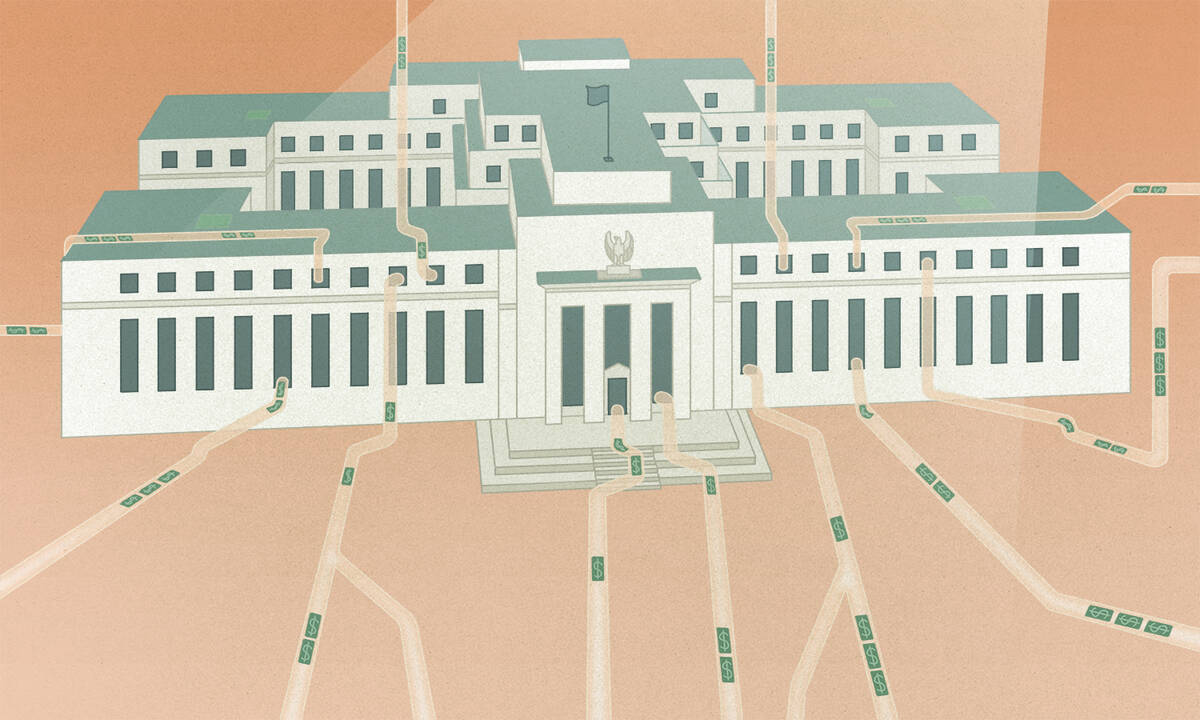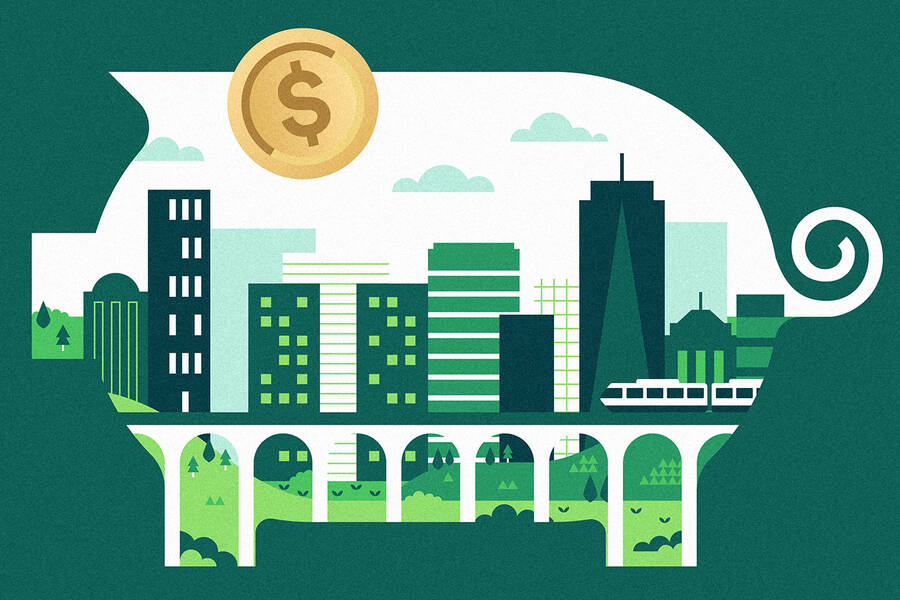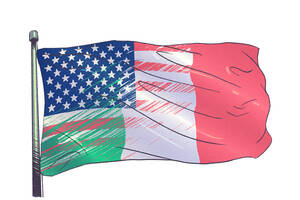
Lisa Röper
With the nation reeling from public-health and economic crises, many economists have urged the President and Congress to act far more quickly and aggressively to deliver aid to unemployed workers, shore up city and state budgets, and otherwise stimulate the economy. In other words, economists want the federal government to go big.
But one federal system has already gone big: the Federal Reserve.
Nicolas Crouzet, an associate professor of finance at Kellogg, just returned from a year at the Federal Reserve Bank of Chicago. He recently spoke with Kellogg Insight to explain the Fed’s “guns-blazing” response to this crisis. He also talks about the Fed’s new approach to inflation, how it might alleviate the next crisis, and what tools may ultimately be needed to get the nation’s economy back on track.
Editor’s note: The opinions and ideas expressed in this conversation are Nicolas’s own; they do not represent, in any way, those of the Federal Reserve System. This conversation has been edited for length and clarity.
Kellogg Insight: So you’ve spent the last year at the Chicago Fed. What have you been up to?
Nicolas Crouzet: I was in their research department as a visiting economist. I had always been interested in seeing how research and policy are done in a central bank. It turned out I picked a really nice year to do this, because it was probably much more interesting to be there this year than in any year since 2008–2009!
KI: I bet. Your visit overlapped with what, by all accounts, has been a fascinating response to the COVID-19 crisis. The Fed has generally been credited for acting quickly and aggressively, with a lot of new programs as well as some programs that were also implemented during the Great Recession. Can you provide a general outline of the Fed’s response?
Crouzet: There are basically two arms: One is what you could call conventional monetary policy, and that just consists of making the interest rate that the Fed controls as low as possible. Before 2009, this is basically all the Fed did: it would set short-term interest rates in a particular funding market for banks. And through that interest rate, other interest rates in the economy would adjust. To slow down an expansion, they would increase that short-term rate; otherwise, they would lower it. That tool has become less powerful over the last decade or so, but the Fed still had a little bit of room at the beginning of this crisis to lower their interest rate. And so the first thing they did was just put the interest rate down to zero.
And then there’s all the rest, which is what the Fed did very aggressively, which people call unconventional monetary policy.
The way I think of unconventional monetary policy is that it tries to achieve two goals. One is short-term stability in financial markets—ensuring that financial markets function relatively smoothly and, in particular, acting as a lender of last resort. That’s really kind of a fire-fighting job, where the central bank is trying to calm panic when it occurs. The other mission is stimulating overall economic activity. So I think of the Fed’s programs as generally having components that address one of these two missions.
What I think was special this time is that the Fed didn’t waste any time in deploying both kinds of programs at a really big scale. They came out guns blazing: it was kind of amazing.
KI: Can you give some examples of what they’re doing to stabilize the financial markets versus stimulate the economy?
Crouzet: So on the stabilization side, one example is that they revamped a program that they had created in 2009 called the TALF, the Term Asset-Backed Securities Loan Facility. That’s a way to stabilize issuance in markets where people trade securities backed by specific assets: credit-card loans and auto loans, among others. When those markets showed signs of instability, the Fed immediately announced that they would bring that program back from the dead. There are other examples: for instance their large-scale intervention in Treasury markets, which also showed some signs of fragility early on in the crisis.
On the stimulus side, an example is that they created the Main Street Lending Program, which was meant as a way to provide credit to small and medium firms that would otherwise have found it difficult to obtain credit from private markets. The idea there was to help jump-start the recovery for these firms and maybe also to avoid excessive liquidations.
My sense of this program is that it has been a big failure, however.
KI: Well, that was my next question. In your personal opinion, how has the Fed been doing? I’m sure you view some of these programs as more successful than others.
Crouzet: I think they did great. There are things that didn’t work out—the Main Street Lending Program is probably the most glaring example. Basically, I think the Fed was trying to step in and take the place of banks. And that’s just hard to do. It’s a very micro job lending to small firms and the Fed is a very macro institution. So coming in and taking the place of these specialized bankers who have complicated, long-lasting relationships with small firms is tricky, and it’s not totally surprising they didn’t achieve their target there.
“You can ask whether the Fed actually has the tools required to really stimulate the economy anymore.”
— Nicolas Crouzet
But if you leave out that program, I think they are doing super well. The response to their stabilization of financial markets in particular has been great.
Now, on the stimulus side, you can ask whether the Fed actually has the tools required to really stimulate the economy anymore. And does its mandate, does its institutional setup, allow it to do what needs to be done right now? And that’s a much bigger question. Within the parameters that the Fed has, I think they did everything they could and they did it really well.
KI: Let’s dig into that deeper question. What makes you question whether they have the requisite tools to respond effectively to the current economic crisis?
Crouzet: For the past 10 years or so, we’ve been in this world of zero interest rates, or close to zero interest rates. And since, at a basic level, most of what the Fed does is basically try to influence interest rates on financial markets, it’s become progressively more difficult for them to effectively stimulate economic activity. What really needs to happen in the context of this crisis is fiscal policy: transfers to households and probably transfers to businesses. These are things that the Fed is not really allowed to do. In general, the Fed is just not allowed to take credit risk. So whenever it puts money out in financial markets, it has to do it in a way where there are no credit losses.
But when you have those constraints, you can’t really stimulate very effectively, say, household credit or corporate credit. You can work at the margins, but it’s not going to have the huge effects that fiscal transfers would have. I think that might be the conundrum that they have right now: they’re doing everything they can, but they may simply not have the right tools for the situation.
KI: So is this restriction on credit risk what’s preventing, say, their Main Street stimulus program from being more effective?
Crouzet: Yes, I think for that program, it was probably one of the bottlenecks. The program is set up so that you can’t lend to the riskiest firms: those with the most leverage or the most reduction in economic activity. And that’s by design, so it doesn’t take any losses on lending to these firms. But this makes it so that you can’t really lend to the firms that would most need it. If the Fed hadn’t had those institutional constraints, it might have been able to say, “Okay, we’re going to lend to a lot of firms. On some of these loans, we’re going to make big losses, but that’s fine. That’s part of a stimulus policy.”
KI: You mentioned the challenges of being in such a low-interest-rate environment, where you lack the room to stimulate the economy further. Are negative interest rates on the table?
Crouzet: There have been talks in academic circles of negative interest rates, which have been implemented in a bunch of European countries. I think the general track record on them is mixed. It hasn’t had super stimulatory effects, and on the downside, it seems to have depressed the profitability of commercial banks. So I think there’s some debate about whether it’s a good policy tool at all.
What the Fed has done is change its inflation-targeting framework, which is related to the problem of low interest rates.
KI: So this is the announcement that the Fed made in August—that it will allow higher levels of inflation.
Crouzet: Yes, though it was in the works before COVID. The Fed has had a formal inflation target of 2 percent since 2012. So every year, the Fed would look at next year’s inflation and basically target 2 percent. What happened over the last 10 years is that the Fed would target 2 percent, and then inflation would come in at 1.7 percent. Year after year. Inflation has been undershooting the target for 10 years! But there was really nothing in the Fed’s mandate that said, “Oh, if you undershoot, well, you have to correct something.” So, the way I think about this new framework is that if they undershoot, they ‘re going to allow themselves to overshoot a bit in compensation going forward. This is called average inflation targeting.
KI: I think many people are a little bit confused about what this means practically, however. Is there concern about inflation going up too quickly?
Crouzet: The Fed’s battle against inflation in the late 70s and early 80s was hard to win and very costly. Basically, the Fed had to engineer a recession to convince the markets that it could control inflation. And so I think some might worry that if the Fed starts messing around with inflation targeting, it’s going to lose the fruits from those hard-won battles. But the reality of it is that inflation hasn’t been north of 2 percent for the better part of 10 years. The Fed is often missing its target. So it seems reasonable to try and do something about it.
And remember: one reason for wanting to have higher inflation is this problem of the lower bound on interest rates. Inflation influences the real interest rate that people face. If your nominal interest rate is zero and you have inflation of 1 percent, then your real interest rate—the interest rate once inflation is taken into account—is actually -1 percent. On the other hand, if your nominal interest rate is zero and you have inflation of 3 percent, then your real interest rate is -3 percent, which is way more stimulative. I personally think that part of the thinking here was, “Let’s try to increase inflation a bit so that the next time we have to push interest rates to zero, the real interest rates are going to be way below zero and we’ll have more stimulus power.”
KI: Speaking of interest rates: the Fed recently announced that they’re going to keep interest rates low through 2023. Is their goal to inspire confidence that, yes, this is the time to do that big new project or expansion you’ve been planning on?
Crouzet: I think so. Their goal is probably to communicate, “We’re going to be giving you an economic environment that’s going to be extremely stimulative going forward.” This is about influencing firms’ and households’ current decisions on spending, but also decisions that are forward-looking. Whenever the Fed can do something to influence people’s expectations about that future, typically, they try to.
KI: A big topic right now is rising income inequality. I wonder how Fed policies potentially intersect with that. So the stock market is flourishing in part because of the actions of the Fed, but many other parts of the economy are really struggling. How is the Fed thinking about whether its actions exacerbate existing inequalities in the country?
Crouzet: There has been a lot of discussion about effects of the Fed’s policies on inequality. You mentioned the Fed boosting the stock market. The Fed doesn’t target the stock market, as they will frequently remind anyone who asks. They’re not trying to raise asset prices. It happens as a side effect of what they do, which is to lower interest rates. When you lower interest rates, you stimulate all asset prices, including the price of equities.
So the Fed may have had large effects on the stock market, but I think that’s really an unintended consequence of their effort to either stabilize markets that are perhaps coming under more stress, like the Treasury bond market or the corporate bond market, or to stimulate the economy overall.
That said, this has effects on wealth inequality simply because the ownership of the stock market is not equally distributed across households. Only 55 percent of Americans own stocks—just 22 percent of Americans in households that make under $40,000. The wealth transfers that result from an increase in stock prices are most concentrated among the highest-income households and the highest-wealth households. It’s almost mechanical. And these unintended consequences will probably be larger, the longer the Fed keeps rates low and policy accommodative.
But as I said before, I think that while direct transfers to households or firms might be required, the Fed can’t really do that; it has to use the tools at its disposal. So these large unintended consequences in asset markets might just be a reflection of the fact that the Fed doesn’t have the perfect tools for our current economic predicament.



